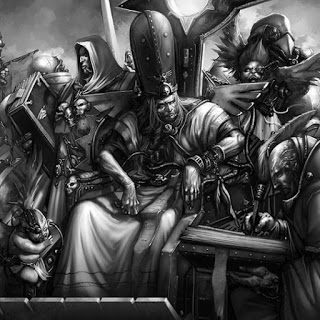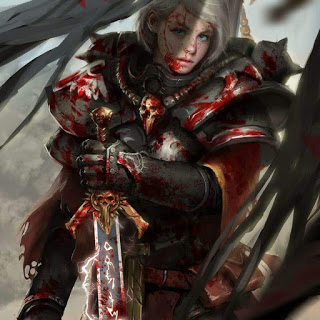The Thorian Reforms
The rise of Goge Vandire to the position of Master of the Administratum, his execution of the Ecclesiarch and his assumption of that position, leading to the infamous Reign of Blood, is well known. So too is his discovery of the Daughters of the Emperor on San Leor and their transformation into his implacable enforcers and concubines the Brides of the Emperor, as well as his eventual defeat and death at the hands of Alicia Dominica, Auditorii Imperator and leader of the Daughters of the Emperor. A man called Sebastian Thor, the leader of an insurgent movement of faithful zealots called the Confereration of Light, was eventually appointed Ecclesiarch and worked tirelessly until his death to both spread the word of the Emperor and reform the Ecclesiarchy.
One of the most significant changes Thor made was the establishment of the Synod Ministra on Ophelia VI as a secondary governing body away from Terra. His intent was two-fold; firstly, to relay and disseminate the dictates of the Ecclesiarch and the Holy Synod, and secondly to act as a defense against the manipulation of the Ecclesiarchy by other organizations or even a single individual within the ranks of the Ministorum itself. Never again would a single clergyman have complete power over the Adeptus Ministorum.
Thor chose Ophelia VII for a number of reasons. Most practically, its distance from Terra, its wealth and extensive administrative and religious buildings made it appealing. Because of the machinations of Cardinal Constantinus Laertes Ophelia VII was ruled directly and exclusively by the Ecclesiarchy. But there were two other motivations the unexpectedly-wily Thor took into consideration.
The first was the effective destruction of the Ophelians as a power bloc by Vandire. In the early stages of his rise to power, before his lucidity deserted him, he realized he could not afford to leave the Laertes Chancery and its allies unmolested - such a cabal would represent an unacceptable threat to his dominance. Painting them, ironically if accurately, as power-hungry men who sought dominance of the Imperium, it was easy for him to order an assault on the Cardinal-Palace of Saint Laertes and find the recalcitrant guilty of capital insubordination in a show-trial. Throughout the Reign of Blood, the Ophelians were kept disunited and off-balance by purges, mercurial favoritism, manipulation and infighting. By the time Sebastian Thor was appointed Ecclesiarch, the Ophelians existed in name-only, reduced to merely the administration of their still-wealthy but politically-impotent planet.
It was an easy matter for Thor to offer them a return to glory and influence in exchange for loyalty and a particular theological emphasis. Because the other reason Thor chose Ophelia as the seat for his secondary governing body was the rise of something called the Temple Tendency.
The Confederation of Light had not sprung out of nothing during the Reign of Blood; it was the heir to a movement of the same name - or perhaps the same movement, enduring in secret through millennia of persecution by the Imperial Creed - which had been the earliest rival to the Temple of the Savior Emperor. The two cults were similar - sects of the same religion and with the same central doctrines - but while the preaching of the Confederation of Light emphasized penitence and sacrifice, the Temple of the Savior Emperor extolled power and wealth.
It was the Temple that emerged victorious from that first schism, but the principles of the Confederation of Light were never fully excised. And, despite the eager acquisition of power both for themselves and the Ecclesiarcy as a whole by the Ophelians, a resistance to the so-called "Temple Tendency" - a desire for wealth, dominance and superiority - ran through the very heart of Ophelian theology, if not always practice.
It had started with Laertes - he had been naive, yes, but he had been pure of heart, defying the jihadist faction of the Brotherhood, refusing coercion and endorsing evangelization. It had continued with the farmers and shepherds of the mountains, their simple and generous existence. And it had culminated in the preaching of men such as Greigor XI, who had emphasized the Emperor's selfless sacrifice rather than his power and glory. The pragmatic Ophelians had perhaps found this theology expedient to keep the people in line and their power and wealth secure, but the end result had been a defiance of the Temple Tendency.
Of course, at this stage in history the Tendency was merely a theological philosophy, not a full-blown heresy the Ecclesiarchy would anathematize over. But Sebastian Thor saw the danger it posed to the success of his reformation - he could not hope to excise the Tendency from the Throne-World of humanity with its corruption, its ancient rivalries and generations-long labyrinthine plots, but he saw in Ophelia an opportunity to - at the very least - establish a bulwark against it.
In this, Thor was aided by the persecution Vandire had visited on the Ophelians; the madman had purged their ranks of the strong, corrupted the weak - but had left what he saw as the inconsequential alone as a sop to the ignorant faithful. The gentle preaching of pious men helped keep the masses cowed and obedient.
During Thor's war of schism, the corrupted Ophelians in league with Vandire were tried and executed by the Confederation of Light on Ophelia, but those who had remained above politics, concerning themselves solely with theology, were not only spared but in fact joined with them, and were perhaps even leaders and spiritual directors of the zealot insurgency.
And so Thor restored the power of the Ophelians in the persons of those of the Laertes family most amenable to the Confederation of Light's ideals. Isolated from Terra and protected by the Ecclesiarch, the Ophelian faction once again rose to a position of great influence in the Adeptus Ministorum and the wider Imperium.
But theological development was not all the Thorian Reformation accomplished. The High Lords of Terra well remembered the horrors of the Age of Apostasy and the Reign of Blood and had no desire to repeat them; while Thor's reforms were oriented not only towards bringing piety and holiness back to the Ecclesiarchy, but also limiting its political power, this was not enough. The High Lords passed the Decree Passive , which forbade the Ecclesiarchy from having any "men under arms" - no longer would the Holy Synod be able to prosecute its own wars, but would have to rely on the armies of the wider Imperium. The Frateris Templars, their fleets and any private armies maintained by Cardinals or priests were disbanded.
But Sebastian Thor and others - including many of the High Lords - recognized some kind of military force was needed and that the Ecclesiarchy could not be totally subservient to the whims of the Adeptus Terra and the Astra Militarum. Thor kept the one army he was allowed under the Decree Passive; due to the archaic wording of the law, the Daughters of the Emperor did not contravene the ban.
Incorporating the sect fully into the Ecclesiarchy was difficult, but eventually they were renamed the Orders Militant of the Adepta Sororitas. Although the High Lords were uncomfortable with this development, they had no legal standing to oppose Thor - and his argument the Adepta Sororitas would regulate the Ecclesiarchy as much as enforce its will did not fall on deaf ears.
Two convents of were established - the Convent Prioris on Terra and the Convent Sanctorum on Ophelia VII. There, the Orders Militant of the Adepta Sororitas were stationed in cloister-fortresses. The warrior-women saw to their own martial training and - supervised and moderated by carefully-chosen priests - their spiritual guidance, but their status as an elite fighting force would only be assured if they were armed and armored with the best technology the Imperium could supply.
Pacts were negotiated between the Ecclesiarchy and the Mechanicus, ensuring the Sororitas would be supplied with unique battleplate, bolters, flamers and melta weapons, even the formidable RH1N0 transport. The soil of Holy Terra was, of course, deemed too-sacred for munitions manufactorums to be built, and so the Convent Prioris was supplied from the forges of Mars.
But on Ophelia VII a different solution was developed, which would lead to the final and complete overturning of the Emperor's edict concerning the mountains.




